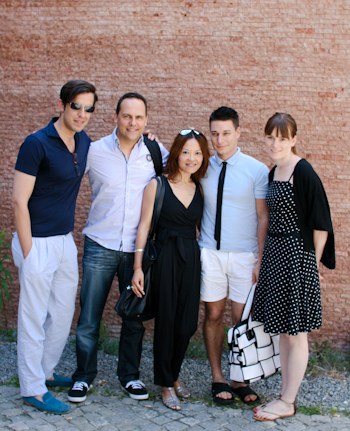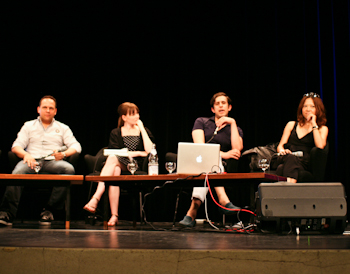Finally, I have a spare moment to mention my experience on the “China – A Chance for Young European Designers” panel in Berlin.
A growing number of foreign fashion designers are landing in China. History’s greatest economic miracle now might provide both markets for foreign brands and employment for foreign talent. This latest generation of foreigners focused on China is young, based here rather than overseas, and sees its future with Chinese companies as this market continues to expand.
我终于有空æ¥å†™åœ¨æŸæž—å‚åŠ çš„ä»¥â€œä¸å›½–年轻欧洲设计师的舞å°â€ä¸ºä¸»é¢˜çš„ç ”è®¨ä¼šäº†ã€‚
越æ¥è¶Šå¤šçš„外国设计师开始在ä¸å›½è½è„šäº†ã€‚ä¸å›½ï¼Œè¿™æ ·ä¸€ä¸ªåŽ†å²ä¸Šç»æµŽçš„奇迹,å‘外国å“牌æ供市场也为外国设计师们的天赋æ供舞å°ã€‚最新的一批年轻的外国设计师选择在ä¸å›½æ‹“宽市场,展望他们的未æ¥ã€‚

In the photo are the panelists: me, Oliver Schütt of TMS Fashion LTd. Beijing, Nicole Chen, Chairman, CEO and Founder of NC.Style, and David Ubl, Art Director of Royal Elastics. Also present is Jennifer Browarczyk, Project Manager at Fashion Patrons GmbH, who moderated the event. Participating in the panel via Skype conference was Nancy Koh, CEO of Hempel Group China.
This was a discussion about what foreign designers must know about working in China and how they might get there. We talked about the challenge of learning the language, working in a Chinese company, and whether one can make real friends in such a foreign culture. David pointed out that networking can occur quickly in Beijing since everyone you need to know is often dining at the same restaurant. Meeting the relevant people is easy in the foreign community and, more importantly, everyone is in a good position and can potentially help with introductions and advice.
The audience – comprised mainly of young designers based in Berlin – was also interested in another question: sourcing. An abiding frustration that rising designers based abroad have with China is that the benefits of low cost production seem off limits since factories will only accept large volume orders. While acknowledging that this problem, the panelists pointed out that many companies are interested in improving the quality and skill of their work. Challenging commissions from smaller designers are a great chance to create samples that can later impress representatives of bigger brands. Also, with the economic slowdown in the West, traditional markets no longer offer fast growth for Chinese brands, who must now explore the domestic market and, potentially, smaller clients.
To get a sense for what the general response to the panel was I asked Jennifer, the moderator and organizer, for some reactions.
NF: Which comments from the panellists stood out most for you?
JB: All of it!!!!I think the most important information for young designers from the panel were the over all situation in China at the moment. It was interesting to hear first hand that European talent is being sought out and welcomed in Chinese companies. I also think that it was helpful to know that production factories are also willing to produce in smaller amounts as a means to show what they are capable of doing. I think this is very valuable especially for young designers interested in setting up their own labels.
NF: What did you think of the panelists – what other relevant people would you have liked to hear from?
JB: It was a great panel with a mixture of people who knew what they were talking about and were able to talk about first hand experience.
NF: After hearing from the panelists, would you recommend that young design students go to China to develop their career?
JB: Yes definitely. I know a lot of young designers looking for good opportunities to use their creativity and talent and I already have suggested to a few of them that they contact Oliver and Nancy and send them their portfolios.I think it is a valuable opportunity for them to kick start their careers, learn and understand the business better and it will open so many doors for them if they use their know how wisely as well as learn from the business, go to the factories, see how the production side is dealt with, and network.
NF: What recommendations would you give them regarding the best ways to do this?
JB: At the moment I would refer them to the panelists that were here. It is so important to have connections and talk to people who can direct you.
NF: What new challenges and opportunities do you expect China to present to the global fashion industry over the next five years?
JB: Challenges will always be there: starting with the language as well as the culture. It is going to be important to find the right people who are willing to move away from their homes and families for longer periods of time to work in a very competitive environment. The rewards though will far outweigh the initial obstacles. I think it is so important for more European designers to make that step and take the risk and they will do brilliantly in the long run. David is a perfect example: only 26 and he has already been able to do so many exciting projects and is now Art Director for Royal Elastics. I do think there is a big chance for the fashion industry in the next years in China to continue to grow.
NF: Thanks, Jennifer
That such a panel happened is interesting in itself and is noteworthy well beyond fashion.
This is quite a change. Formerly, most design work occurred abroad, while the manufacturing occurred here. Chinese brands would essentially study the products of foreign companies and, to a great extent, recreate it with minor tweaks aimed at making the product less expensive or more adapted to the local market. Over the last decade or so, we have witnessed foreign brands transferring their design offices to China as well – to take advantage of the huge pool of inexpensive talent. This trend has caused jitters as it seems now that not only production but also innovation and creativity can be moved to China, leaving the West a barren landscape of retail outlets and corporate headquarters (probably staffed by overseas Chinese).
But this sort of forum provides more than a glimmer of hope. To become more international and even to create products that rival those of foreign brands in the domestic market, some Chinese companies are turning to foreign talent, at least on the creative side. These numbers are likely to increase – in the short-term at least. Chinese companies will be acquiring more foreign brands and seeking foreign designers to maintain international competitiveness. One question in my mind is whether foreign designers will remain in competitive in the medium-term as their Chinese counterparts become more skilled, worldly, and creative. Will it still make sense to hire a foreigner if locals are just as capable of performing the job? Already, we see many major foreign brands relying on their design houses here in China for all but the most conceptual work. The technical skills of local designers often are stronger than foreigners, who might stronger creatively. Let us just hope that there will be opportunities for all.
照片里是å‚åŠ åº§è°ˆä¼šçš„äººï¼šæˆ‘ï¼Œæ¥è‡ªTMS Fashion LTd.北京部门的Oliver Schütt,NC.Style的创始人兼首å¸æ‰§è¡Œå®˜Nicole Chen,以åŠçš‡å®¶æ©¡çš®ç‹å“牌的艺术指导David Ubl。Fashion Patrons GmbH的项目ç»ç†Jennifer Browarczyk是这次活动的主æŒäººã€‚赫普ä¸å›½çš„首å¸æ‰§è¡Œå®˜Nancy Koh通过Skype也å‚åŠ äº†è¿™æ¬¡åº§è°ˆä¼šã€‚
这次我们讨论了有关国外设计师如何了解如何到ä¸å›½å¼€æ‹“市场以åŠåœ¨ä¸å›½å·¥ä½œçš„现状。我们说了很多,有å¦ä¹ è¯è¨€çš„挑战,在ä¸å›½å…¬å¸å·¥ä½œçš„ä¸åŒï¼Œä»¥åŠå¦‚何在一个全新的文化环境ä¸ç»“交真æ£çš„朋å‹ã€‚Davidè¯´å…¶å®žåœ¨åŒ—äº¬ç§¯ç´¯äººè„‰å¾ˆå®¹æ˜“ï¼Œå› ä¸ºä½ éœ€è¦è®¤è¯†çš„æ¯ä¸€ä¸ªäººä¼¼ä¹Žéƒ½åœ¨åŒä¸€ä¸ªé¤åŽ…åƒé¥ã€‚认识åŒè¡Œçš„人在ä¸å›½å¹¶ä¸éš¾ã€‚æ›´é‡è¦çš„是,æ¯ä¸ªæœ‰ä¸€å®šä½ç½®çš„人都很å¯èƒ½å¸®åŠ©ä½ ï¼Œç»™ä½ æ供介ç»å’Œå»ºè®®ã€‚
到会的观众们主è¦æ˜¯æŸæž—的年轻设计师。他们也åŒæ ·å…³å¿ƒå¦å¤–一个问题:资æºã€‚这是一个一直困扰这些新生的设计师们在ä¸å›½å‘展的问题,低æˆæœ¬çš„生产é™åˆ¶äº†å·¥åŽ‚一般都åªæŽ¥æ‰¹é‡ç”Ÿäº§çš„大å•ã€‚承认问题å˜åœ¨çš„åŒæ—¶ï¼Œä¸Žä¼šæˆå‘˜ä¹ŸæŒ‡å‡ºï¼Œå¾ˆå¤šå…¬å¸å…¶å®žéƒ½å¾ˆæ„¿æ„æå‡ä»–们产å“çš„å“质与工人的技术。挑战ä¸æ˜¯å¤§ç‰Œçš„设计师的订å•ï¼Œä¹Ÿç®—是为了日åŽå¯ä»¥ç»™å¤§å“牌留下深刻å°è±¡ã€‚并且,éšç€è¥¿æ–¹ç»æµŽèµ°ä¸‹å¡è·¯ï¼Œä¸å›½çš„很多å“ç‰Œæ— æ³•åœ¨ä¼ ç»Ÿçš„å›½å¤–å¸‚åœºä¸å¿«é€Ÿç›ˆåˆ©ï¼Œæ‰€ä»¥ä»–们ä¸å¾—ä¸åœ¨æœ¬åœŸå¸‚场,很å¯èƒ½ä¼šä»Žå°å®¢æˆ·é‚£é‡Œå¦è¾Ÿå‘展的é“路。
为了了解大家对这个座谈会的åå“,我问了主æŒäººå’Œç–划者Jennifer一些问题。
NF: 会议上的哪些å‘è¨€ä»¤ä½ å°è±¡æœ€æ·±ï¼Ÿ
JB: 全部å‘言ï¼æˆ‘觉得其ä¸å¯¹äºŽå¹´è½»è®¾è®¡å¸ˆæœ€é‡è¦çš„ä¿¡æ¯å°±æ˜¯ä¸å›½æ•´ä½“çš„æƒ…å†µã€‚è¿™æ ·ç›´æŽ¥äº†è§£åˆ°ä¸€æ‰‹ä¿¡æ¯ï¼ŒçŸ¥é“ä¸å›½å¾ˆå¤šå…¬å¸å¯¹æ¬§æ´²è®¾è®¡å¸ˆä»¬å…¶å®žæ˜¯çœ‹å¥½çš„还是很有趣的。知é“厂商们也会愿æ„接å°å•æ¥è¯æ˜Žä»–们的能力也很有帮助。总体æ¥è®²ï¼Œè¿™äº›ä¿¡æ¯å¯¹äºŽæƒ³è¦è‡ªå·±æˆç«‹å“牌的年轻设计师都很有价值。
NF: ä½ è§‰å¾—å‚åŠ å‘言的æˆå‘˜ä»¬æ€Žä¹ˆæ ·ï¼Ÿæœ‰ä»€ä¹ˆå…¶ä»–æ–¹é¢çš„相关人员的æ„è§æ˜¯ä½ 也想å¬å¬çš„呢?
JB: 这次å‚åŠ çš„äººå‘˜ä»Žä¸åŒæ–¹é¢ä¸ºå¤§å®¶è®²ä»–们的亲身ç»éªŒï¼Œéƒ½å¾ˆæ£’。
NF: 那么å‚åŠ å®Œè¿™æ¬¡ä¼šï¼Œå¬åˆ°è¿™äº›ä¸åŒçš„å£°éŸ³ï¼Œä½ ä¼šæŽ¨èå¦è®¾è®¡çš„å¦ç”ŸåŽ»ä¸å›½å‘展么?
JB: 当然会啊。我认识ä¸å°‘很有天赋和自己的想法,åŒæ—¶ä¹Ÿåœ¨æ‰¾æœºä¼šçš„年轻设计师,而且我也已ç»å»ºè®®å…¶ä¸ä¸€äº›è”ç³»Oliverå’ŒNancy,把自己的作å“å°æ ·æ‹¿ç»™ä»–们看。这å¯ä»¥å¸®åŠ©ä»–们把自己的事业开好头,实在是一个很难得的机会。他们å¯ä»¥äº²è‡ªåŽ»å·¥åŽ‚看制作是怎么具体执行的,注æ„积累人脉ç‰ç‰ï¼Œåœ¨å®žè·µä¸å¦ä¹ 。
NF: é‚£ä½ å¯¹ä»–ä»¬éƒ½æœ‰ä»€ä¹ˆå»ºè®®å‘¢ï¼Ÿ
JB: 至少目å‰æˆ‘会推è他们认识å‚åŠ åº§è°ˆä¼šçš„äººä»¬ã€‚è®¤è¯†èƒ½å¼•å¯¼ä½ å¸®åŠ©ä½ çš„äººå®žåœ¨æ˜¯å¤ªé‡è¦äº†ã€‚
NF: 在未æ¥çš„äº”å¹´é‡Œï¼Œä½ ä¼°è®¡ä¸å›½ä¼šç»™å…¨çƒæ—¶å°šäº§ä¸šå¸¦æ¥ä½•æ ·çš„挑战和机é‡å‘¢ï¼Ÿ
JB: 挑战总是会有的:先从了解è¯è¨€å’Œæ–‡åŒ–开始å§ã€‚找到愿æ„背井离乡在ä¸å›½è¿™æ ·å……满竞争的环境下工作的人是很é‡è¦çš„。ä¸è¿‡æ¯”起最åˆçš„艰辛,获得的收获ç»å¯¹æ˜¯å¤šå¾—多的。欧洲设计师们如果åšå¥½å†³å®šï¼Œæ„¿æ„接å—è¿™æ ·çš„æŒ‘æˆ˜ï¼Œä»Žé•¿è¿œæ¥çœ‹ï¼Œä»–们一定都会åšçš„很好的。David就是一个很好的例å:他现在æ‰26å²ï¼Œå°±å·²ç»æŽ¥å—了那么多激动人心的项目了,而且现在还担任皇家橡皮ç‹å“牌的艺术指导。我åšä¿¡ï¼Œæœªæ¥å‡ 年内ä¸å›½çš„时尚产业会å‘展得更好的。
NF: è°¢è°¢ä½ æŽ¥å—采访,Jennifer。
这个座谈会的开展本身就很有æ„义,已ç»è¶…越了时尚本身了。
转å˜å®žåœ¨æ˜¯å¾ˆå¤§ã€‚以å‰ï¼Œæ›´å¤šçš„è®¾è®¡å·¥ä½œéƒ½åœ¨å›½å¤–ï¼Œå›½å†…å¤§å¤šè´Ÿè´£ç”Ÿäº§åŠ å·¥ã€‚ä¸å›½å“牌还必须从很大程度上å‘外国公å¸çš„产å“å¦ä¹ ,改善自己的产å“令其更为廉价或者更适应本土市场。在过去近å年内,我们目ç¹äº†å¤–国å“牌为了节çœæˆæœ¬æŠŠå…¬å¸é€æ¸è½¬ç§»åˆ°ä¸å›½è¿™æ ·çš„过程。ä¸è¿‡è¿™æ ·çš„è¶‹åŠ¿ä¹Ÿå®¹æ˜“è®©æœ‰çš„äººæ„Ÿåˆ°ç´§å¼ ï¼Œå› ä¸ºä¼¼ä¹ŽçŽ°åœ¨çœ‹ä¸ŠåŽ»å¥½åƒä¸åªæ˜¯åˆ¶ä½œåŠ 工,创æ„å’Œè®¾è®¡çš„éƒ¨åˆ†ä¹Ÿä¸€æ ·å¯ä»¥è½¬ç§»åˆ°ä¸å›½å®Œæˆï¼Œè¿™æ ·ä»¥æ¥ç»™è¥¿æ–¹ç•™ä¸‹çš„就是零售店和公å¸æ€»éƒ¨äº†ï¼ˆæœ‰å¯èƒ½é›‡ä½£çš„还是在海外生活的ä¸å›½äººï¼‰ã€‚
ä¸è¿‡è¿™æ ·çš„讨论会还是为大家æ供了更多的希望。为了å˜å¾—更有创æ„,更为国际化甚至为了对抗æ¥è‡ªå¤–国å“牌的竞争,一些ä¸å›½å…¬å¸å‘外国设计师抛å‘橄榄æžã€‚è‡³å°‘åœ¨æœ€è¿‘è¿™æ ·çš„è¶‹åŠ¿åªä¼šæœ‰å¢žæ— å‡ã€‚ä¸è¿‡æˆ‘的疑问是é¢å¯¹æ¥è‡ªä¸å›½çš„åŒè¡Œä»¬å·²ç»å˜å¾—越æ¥è¶Šæœ‰åˆ›æ–°ç²¾ç¥žå’Œé€‚应国际环境,外国设计师们是å¦èƒ½ä¿æŒä»–们的竞争力至少在ä¸æ¸¸å‘¢ã€‚如果ä¸å›½è®¾è®¡å¸ˆè‡ªå·±å°±å¯ä»¥åšå¾—很好,那雇佣外国设计师还有æ„义å—?我们已ç»çœ‹åˆ°äº†ä¸å°‘外国的大å“牌们邀请ä¸å›½çš„设计师æ¥ä¸ºä»–们åšæ¦‚念性的创æ„工作了。而专业技能方é¢ï¼Œæœ¬åœ°è®¾è®¡å¸ˆå¾€å¾€éƒ½æ¯”外国设计师è¦å¼ºï¼Œè™½ç„¶å¤–国设计师更善于创æ„。还是让我们希望æ¯ä¸ªäººéƒ½å¯ä»¥æœ‰æœºä¼šå§ã€‚

Comments are closed.